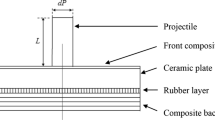Abstract
It is shown how the experimental data on ballistic limit velocity (BLV) of two-component ceramic target may be directly used for the analysis and optimization of the armor. The suggested approach is applied for two sets of data available in the literature.
Similar content being viewed by others
REFERENCES
Ben-Dor, G., Dubinsky, A., Elperin, T. and Frage, N. (1999). Optimization of two component ceramic armor for a given impact velocity. Theoretical and Applied Fracture Mechanics, in press.
Florence, A. L. (1969). Interaction of projectiles and composite armor. Part 2, Stanford Research Institute, Menlo Park, AMMRC-CR-69-15.
Hetherington, J. G. (1992) The optimization of two-component composite armors. International Journal of Impact Engineering, 12, 229-259.
Hetherington, J. G. and Rajagopalan, B. P. (1991). An investigation into the energy absorbed during ballistic perforation of composite armors. International Journal of Impact Engineering, 11, 33-40.
Wang, B. and Lu, G. (1996) On the optimization of two-component plates against ballistic impact. Journal of Materials Processing Technology, 57, 141-145.
Wilkins, M. L. (1978). Mechanics of penetration and perforation. International Journal of Engineering Science, 16, 793-807.
Author information
Authors and Affiliations
Rights and permissions
About this article
Cite this article
Ben-Dor, G., Dubinsky, A. & Elperin, T. Optimization of Light Weight Armor Using Experimental Data. International Journal of Fracture 100, 29–33 (2000). https://doi.org/10.1023/A:1018789410089
Issue Date:
DOI: https://doi.org/10.1023/A:1018789410089




